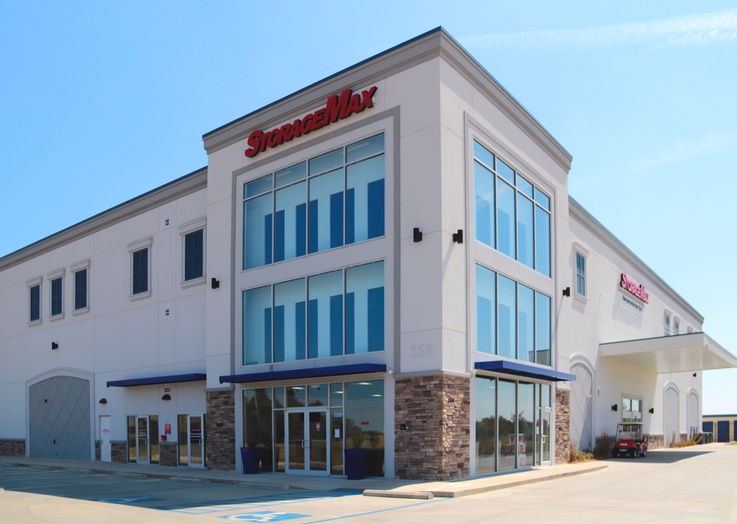2021 International Facility Of The Year Mr.[B] Hincapié, Guatemala City, Guatemala
Guatemala City sits cradled in a vivid, mountainous area called Valle de la Ermita (Valley of the Hermitage) in Guatemala’s south-central region.
The city is Guatemala’s capital, largest city, and economic, administrative, and cultural center. Guatemala City had an estimated population in late 2021 of nearly 995,000 and a metropolitan-area population of nearly 2.5 million, according to World Population Review. The country’s estimated population of nearly 18.4 million makes it the most populous Central American country.
Guatemala City’s population makes it a desirable market for self-storage. One of its self-storage companies was founded there in 1997 as Mr. Bodeguitas and started operating in 1998. Now it has 12 facilities: eight in Guatemala City and four more in Costa Rica and El Salvador (which won Mini-Storage Messenger’s international Facility of the Year Award in 2016). It also has three more under development in those two countries.
Starting with its latest facility, Mr.[B] Hincapié in Guatemala City, the company rebranded itself as Mr.[B] Self Storage. This latest Mr.[B] facility also caught the attention of Mini-Storage Messenger, which named it as International Facility of the Year for 2021.
Adapting In The City
Mr.[B] Hincapié is located on an intertown road with extensive façade visibility for passing traffic and the nearby airport’s only runway, which is 1,000 feet from the facility. The facility’s striped, multicolored exterior makes brand recognition easy. Its six-story façade with a lighted dummy-door window showcase lets natural light into all floors.
Guatemala is called “the land of the eternal spring.” Accordingly, the facility’s design creates a natural wind flow with a metal lattice beside indoor stairs and louvers in front windows to control humidity and temperature naturally.
Federico Rolz, CEO of MBI Management Corp., which owns Mr.[B] Self Storage, says Mr.[B] Hincapié presented several unusual and in some cases unique problems to solve. Restrictions and delays caused by COVID-19 posed new problems to solve in the construction process. Mr.[B] Hincapié was the company’s first conversion project and required it to integrate two existing buildings, build a new one, and then integrate all three into one. The company needed to educate city officials about self-storage, and city permitting approval took 14 months.
“In older, more established cities, you have to learn how to adapt those buildings to storage,” Rolz says.
The project required an extensive structural engineering redesign, complicated by initially having only handmade blueprints of the original buildings, which Rolz says were built in the early 1990s. This required the company to reproduce the blueprints electronically. The company submitted redesigned blueprints three months after it had purchased the land.
The need for complete blueprints of the pre-existing buildings to ensure sufficient structural engineering was especially important in Guatemala since, as Rolz notes, the region is prone to massive earthquakes. Because of that, the facility has an eccentric brace framing structural system. It supports live loads of 133 pounds per square foot, exceeding the American Society of Civil Engineers’ 125 per square foot recommendation. The roof was designed to withstand volcanic ash live loads because of the area’s risk of volcanic eruptions.
Converting an old building brings “a lot of surprises,” necessitating detailed supervision and decision-making to ensure the final product’s quality, says Daniel Hernandez, MBI’s development manager. With Mr.[B] Hincapié, inserting structural reinforcements and expansion joints to connect the buildings, improving the condition of existing slabs, ensuring equality of topographic floor levels, and making other structural improvements, along with implementing architectural details to make the three buildings into one, were all unusual aspects of the project.
“The scope and plan were changing weekly, but the goal always remained the same,” says Rolz.
The facility’s street-level, fully covered parking lot—the first in Guatemala—gives tenants a covered loading bay for moving trucks and containers and covered parking spaces for unloading smaller items. A nearly 12-foot-high perimetral enclosure “makes a strong first security ring that gives our customers the peace of mind of being in a secure area,” Hernandez says. Tenants can open the gate only with a phone app or access code. The facility also has three outside visitor parking spaces.
Mr.[B] Hincapié has two elevators, both with 5-foot-wide doors and 4,000-lb. capacities: one at the loading bay level and another at the parking lot level to make loading and unloading more efficient. A foreign company was hired to install hallways and internal partitions. Another company was hired and trained to do drywall work.
The facility has smart entry alarms, polished floors, bright LED lighting, stainless steel and rubber sheet-protected elevators, and an ambient sound system throughout.
The team worked remotely during delays caused by governmentally imposed pandemic restrictions. The company used an onboarding and training app and real-time implementation of procedures and sharing of information and decisions.
“We were able to get the most from the team and make them feel safe working at the facility,” Rolz says. “Through the technology, we became close as team members,” and the app also enabled team member to give feedback to management.
The company’s written submission for consideration for the award says the site closed for three weeks in March and one week in April 2020 because of the government-imposed restrictions.
“The first three months were tough, but then everything worked well,” he says. “Two things: We put our people first, and we take long-term view for our customers,” which meant giving customers leeway on paying rent because of COVID-caused difficulties. The construction and operational teams worked remotely and on site to increase their flexibility.
The company made other adjustments to their normal processes, including having the general contractor modify entry to the building and control personnel’s movements, adopting new safety measures, including increased sanitization, and complying with other government-required health and safety measures and documents. It also uses touchless access controls, temperature controls, customer visit logs for contact tracing, hand sanitizer dispensers throughout the facility, digitized processes, and remote, digital leasing.
Disrupted public transportation complicated the ability of workers and the company’s staff to get to and from the site. Many carpooled and shared expenses. Others used bicycles. The company provided no-interest financing for some staffers to buy motorcycles to get to and from the site. It also rented a bus that followed a specific daily route.
The construction site even became an off-hours temporary hotel for those who didn’t want to travel to and from the site. And the company hired a food vendor to provide three meals a day and a mid-morning snack for the crew.
Safe And Secure
Mr.[B] Hincapié has continuously present armed guards and 80 surveillance cameras monitored offsite year-round by a private security company. An access log is used for all site visits. Private security company supervisors visit the facility several times daily, including evenings.
The facility also uses the Nokē smart entry system, and it’s the first use of the system in Central America, says Pete Frayser, vice president of sales and estimating for Janus International. Use of the system means Mr.[B] is “really forward thinking.”
“They’re trying to get in front of the curve and incorporate some of the technology that we’ve developed and are putting into facilities in the U.S.,” says Frayser, adding that Janus had few difficulties installing its products in the facility. In his prior job with Janus, as head of international sales, he worked closely with Rolz and the relationship “is very smooth.”
“The supply chain has put crunch on availability of space on shipping containers,” Frayser says. “In this instance, it was kind of difficult to get material down there due to a lack of availability on ships. Outside of that, things ran pretty smoothly. It’s not our first rodeo. We’ve done a lot of business with them down in that part of the world, so it’s kind of business as usual for us.”
Janus was in contact with the Mr.[B] team starting with in the design phase, and “that’s our bread and butter, so we deal with that stuff all the time,” he says. “We were able to leverage in-house knowledge that we have to make sure everything ran smoothly.”
Janus had to think about access to the site to get materials inside and move them around. “Being in lockstep” on the project’s front end eased getting a jump on any potential problems. The Mr.[B] team is “very accommodating” and know how to work with Janus’ material.
“They’re a big-time developer in Central America and the Caribbean,” says Frayser, “so they’re about as easy as they come as far as overseas customers.”
Urban sites such as Mr.[B] Hincapié are often hard to develop, Frayser says. That Mr.[B] was able to maximize the facility’s footprint and rentable square footage so much space in a concentrated makes the facility unique.
“I’m really happy for those guys,” Frayser says. “I think their partnership with American investors and partners really puts them in a unique position to capitalize on what I think is still a very green and underserved market. I’m very proud of those guys and I’m bullish on their future.”
Mr.[B] used technology and training for remote operations. It hired a storage consultant experienced in supporting other existing facilities and learning necessary processes, and it used an onboard training app called ACTIMO by Kahoot, which tracks necessary learning before qualifying personnel.
Operational And Marketing Challenges
The company recently established the Guatemalan Storage Association to address a lack of lien laws, which make eviction and lien sales difficult to execute. Collections constitute a large portion of operational expenses. The company adapts out-of-the-box systems to existing local tax requirements. Fiscal laws in Latin American countries require integration with banking and governmental revenue service-approved institutions and their systems. This is especially important for international growth.
Regarding marketing, the company changed its name to Mr.[B] for a few main reasons, Rolz says. The word “bodeguitas” has different meanings in different Spanish-speaking countries, including “small storage space,” “small convenience store,” and “small pub.” So, the company wanted to make its name better understood in various countries.
Also, the company’s prior logo recalled a 1940s-era, strong factory worker, but this didn’t depict modern, technologically advanced facilities. And women users of self-storage have increased relative to men users, so the company wanted a less industrial and more upscale look with a color scheme thought to be more inviting to women.
Mr.[B] leads the market and “everybody follows our pricing,” Rolz says. It holds 43 percent of Guatemala’s market and 50 percent of El Salvador’s market. Plus, it’s increasing its shares of Costa Rica’s and the Dominican Republican’s markets. Central America comprises seven small countries: Guatemala, Belize, El Salvador, Honduras, Nicaragua, Costa Rica, and Panama. Their combined population is 48 million, larger than California’s, and their combined gross domestic product of $250 billion is comparable to South Carolina’s.
According to Rolz, Mr.[B] usually relies heavily on drive-by traffic to market its brand and facilities. But the pandemic meant fewer people were out and about, more people worked from home, and airports were closed. The company responded by expanding its digital marketing and revamped its website. Its online booking system centers on three questions for self-storage customers: Where do you want to rent storage? What kind of storage do you need? And how much does it cost? Then customers choose their units online. COVID led to walk-ins decreasing from 41 percent to six percent in 2020, but online bookings have increased from 37 percent to 67 percent of total bookings.
The company pushed its brand and lead generation with various methods, including Instagram stories by local influencers, short videos of customer success stories, ads on its Facebook page, and charity-sponsored and entrepreneurship events.
It also used what’s called “guerrilla marketing,” such as flyer distribution, bike billboards (small ads on bicycles in areas with heavy car traffic), and a mobile marketing truck. It also advertised in magazines and digital newspapers.
Demographic, city growth, and traffic volume information are limited in most Central American cities, which poses problems for self-storage feasibility studies. The company developed a site-selection sheet and feasibility study using its own data and valuation formula. It built its first facility more than 20 years ago, less than a mile from Mr.[B] Hincapié, and area competition was heavy.
The facility serves two of Guatemala City’s wealthiest areas, one called the “Manhattan of Guatemala,” and the other a longtime financial district in which the city is promoting high-end residential construction. The company’s customer base has shifted from 85 percent commercial and 15 percent residential to a 50-50 split with peaks of 65 percent residential.
The facility’s manager’s office is situated to enable oversight of movement in and out of the parking lot and the car entrance, pedestrian visits, and the conference rooms. Free conference rooms and co-working spaces are provided for commercial tenants. Rolz occasionally approaches tenants in the facility to asked them what they like most about it because he “wanted to really understand what the customers were experiencing with those things and how to replicate those.”
Hernandez says that when construction on Mr.[B] Hincapié was complete, “we all realized that this project had become an emotional achievement for everybody.”
“Working at the site through a global pandemic with the uncertainties of an unknown new disease was hard for everybody,” says Hernandez, “but after a few weeks, people came in with a strong spirit and the willingness to move forward. That sentiment was all around the site, and we became one team with the same goal. Many sacrifices were made, many families apart, endless efforts, and genuine passion. A special thanks to all the Guatemalan workforce.”
Clearly, Mr.[B] Hincapié embodies two of the company’s key characteristics.
“We’re a very structured and determined company that’s focused only on self-storage, on becoming the best in Latin America,” says Rolz.
Facility name: Mr.[B] Hincapié
Location: Guatemala City, Guatemala
Opening date: September 2020
Site acreage: About half an acre (1,643 square meters)
Height: Six stories
Number of units: 510
Rentable area: 45,531 square feet (4,230 square meters)
Average unit size: 97 square feet (9 square meters)
Occupancy as of mid-October 2021: About 50 percent
Project cost: $5.8 million
Owner and facility manager: MBI Management Corp.
Builder: Construcciones Nabla
Architect: Alternativa Arquitectura
Structural engineer: Estruconsult S.A.
Security provider: El Ebano
Access system and smart locks: Nokē by Janus International
Management software system: SiteLink
Accounting system: SAP Business One
Roof: Aceros Nabla S.A.
Door and interior system: Janus International
More Content
Popular Posts
Recent Posts
When Germantown High School in Gluckstadt,...
It’s comforting to know that no matter how...
A very wise self-storage expert once said...
Senate Bill 709 (SB709) has many in the...
In January, self-storage industry veteran...
In April 1984, the first non-stop commercial...
Raise your hand if you’ve ever made plans,...
Everyone knows it: Investing in real estate...









